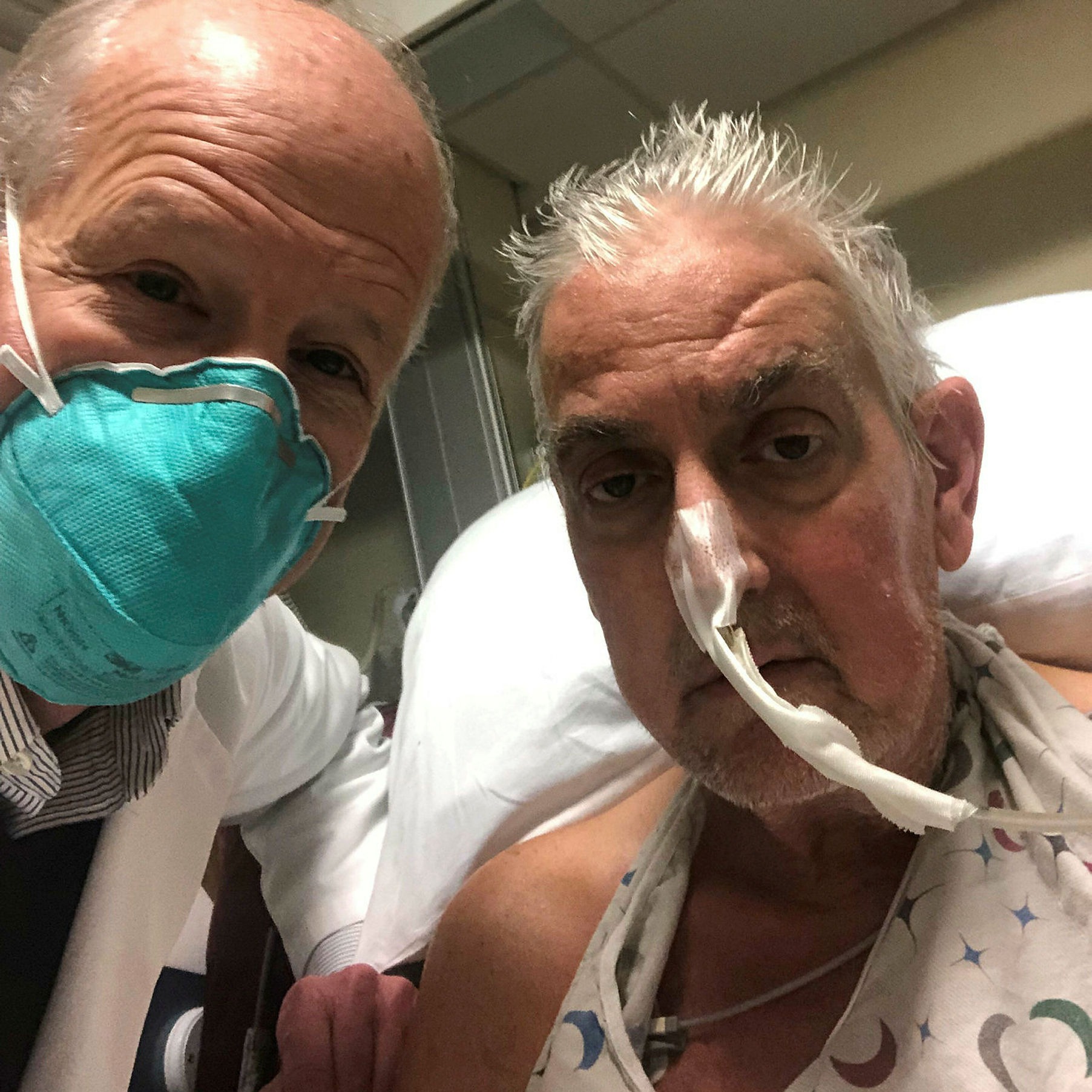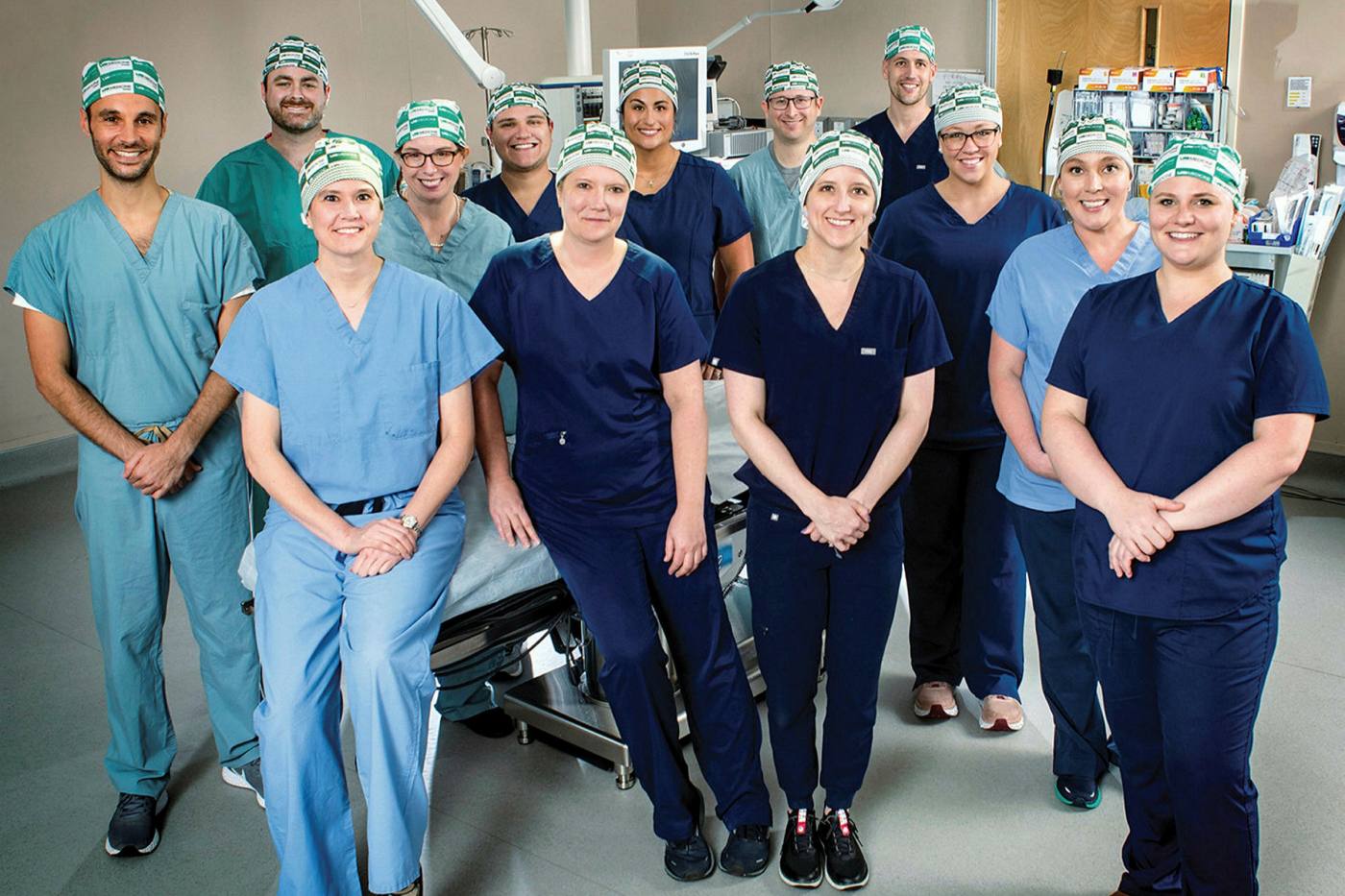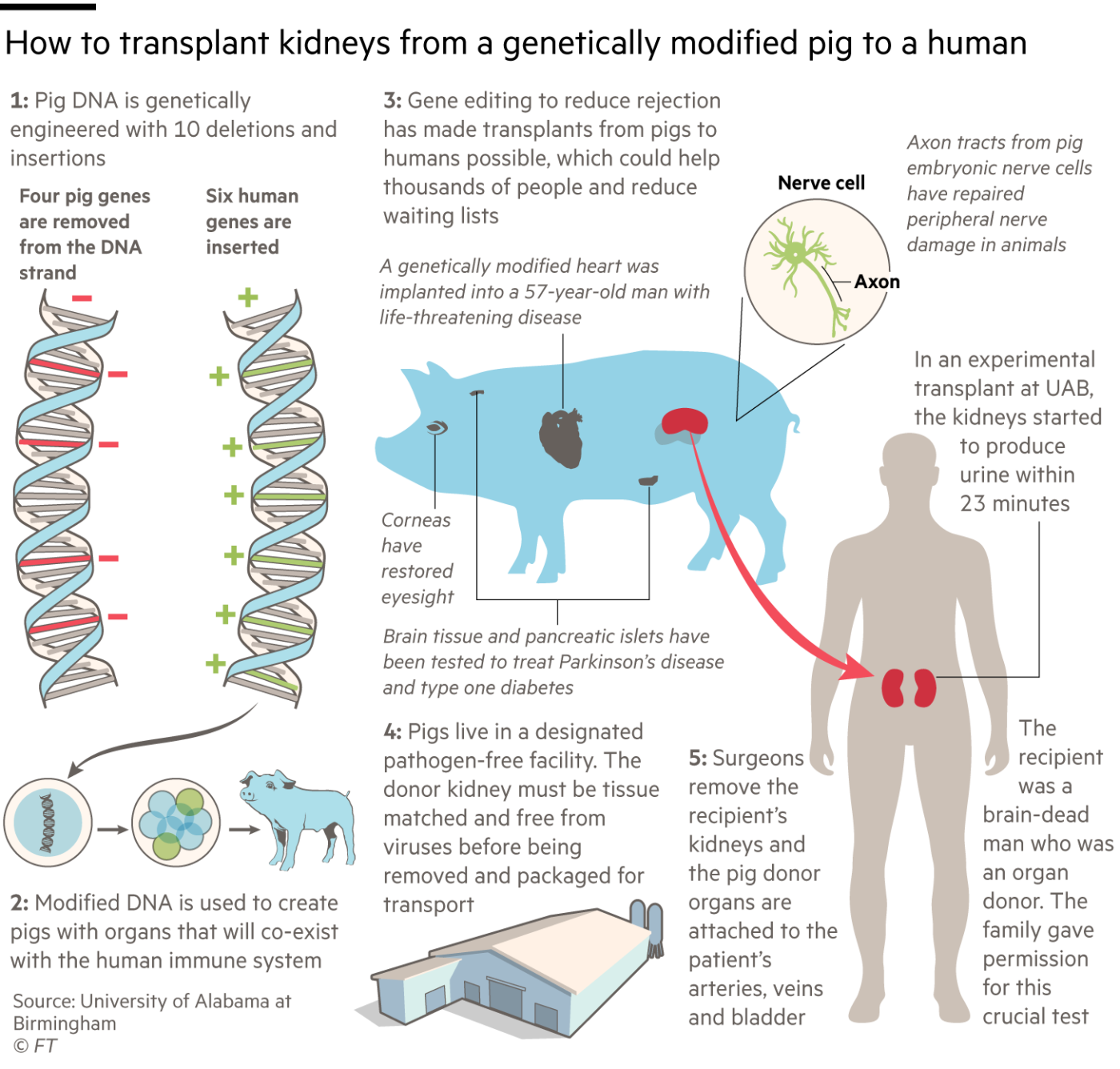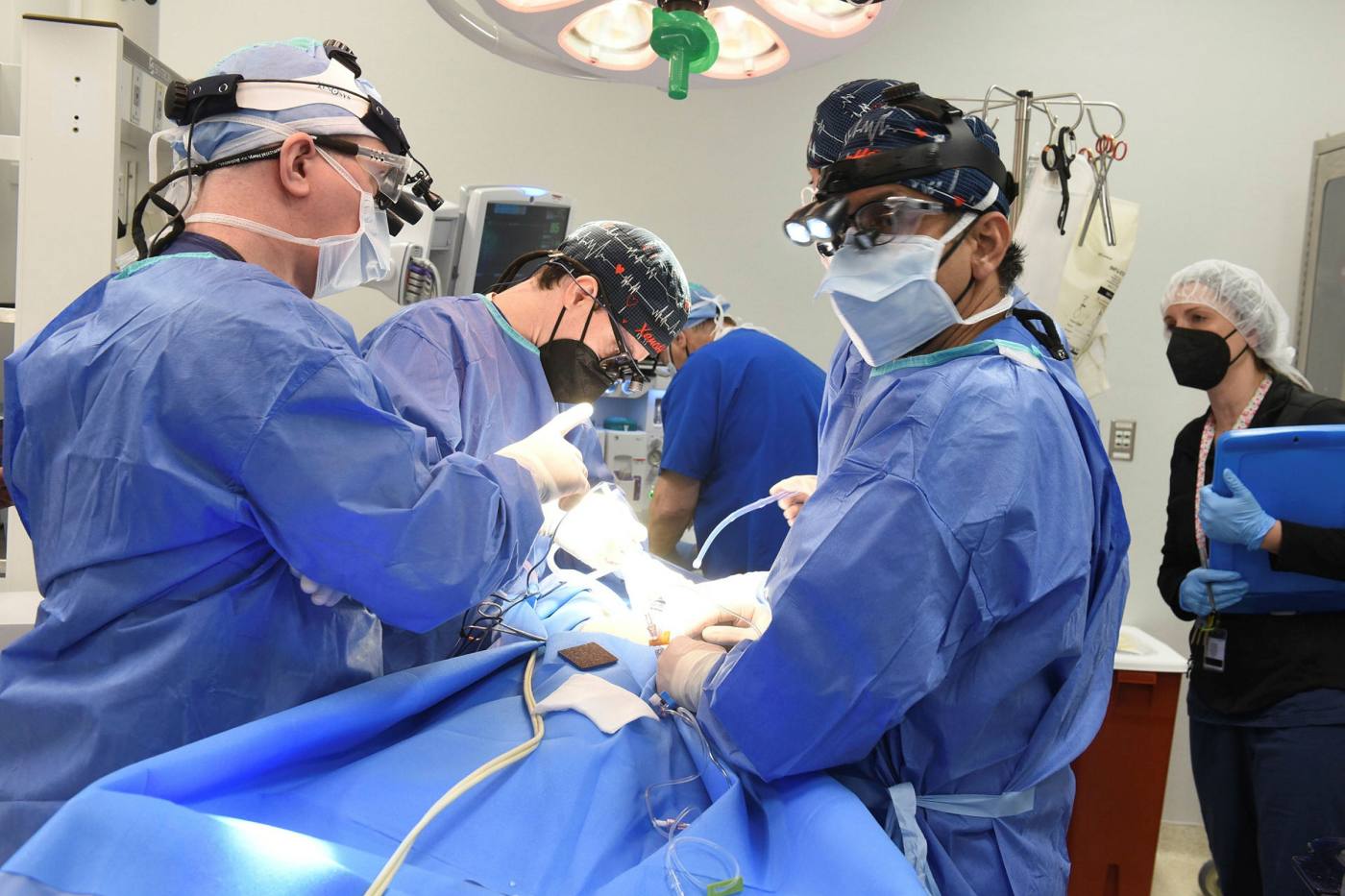尊敬的用户您好,这是来自FT中文网的温馨提示:如您对更多FT中文网的内容感兴趣,请在苹果应用商店或谷歌应用市场搜索“FT中文网”,下载FT中文网的官方应用。
“Pig hearts to be tested in humans” read a headline in the Financial Times in September 1995. The article quoted confident predictions that porcine hearts, genetically engineered to avoid rejection, would be transplanted into patients the following year — helping to ease the worldwide shortage of human organs.
1995年9月,FT发表了一篇题为“猪心脏将在人体中进行测试”的文章。这篇文章引用了有信心的预测,通过基因工程来避免排斥反应的猪心脏将在次年被移植到病人体内,这有助于缓解全球人体器官短缺的问题。
More than 25 years passed before that forecast finally came true. Last month surgeons at the University of Maryland School of Medicine in Baltimore successfully replaced the failing heart of a 57-year-old man with a fresh one from a pig with 10 gene edits. Four weeks later the patient, David Bennett, continues to recover with no signs of rejection.
25年后,这一预测终于成真。上个月,位于巴尔的摩的马里兰大学医学院的外科医生们成功地用一头带有10个基因编辑的猪的新鲜心脏替换了一名57岁男子衰竭的心脏。四个星期后,病人大卫·贝内特(David Bennett)继续康复,没有出现排斥反应的迹象。
Xenotransplantation — replacing human organs with those from other species, typically referred to as “xeno” by scientists — has followed cycles of hope and disappointment dating back at least to 1984 when surgeons in California gave Baby Fae, born with a lethal cardiac defect, a baboon’s heart which failed after three weeks.
异种移植——用科学家通常称之为“异种”的其他物种的器官取代人类器官——经历了希望和失望的循环,至少可以追溯到1984年,当时加州的外科医生给有致命心脏缺陷的婴儿菲(Fae)移植了一只狒狒的心脏,这颗心脏在三周后衰竭。
Now, after decades of anticipation, a new era of medical innovation could be within grasp, propelled by advances in gene editing, including Crispr technology, animal cloning and immunology. At the same time fears that transplants could transfer viruses from animals to humans, which almost killed xeno research in the late 1990s, have eased.
如今,经过几十年的期待,在Crispr技术、动物克隆和免疫学等基因编辑技术的进步推动下,医疗创新的新时代可能即将到来。与此同时,对移植会将病毒从动物传染给人类的担忧也有所缓解。在20世纪90年代末,这种担忧几乎扼杀了异种动物研究。
The Maryland cardiac team surprised the world of medicine with its announcement of a transplant of a pig’s organ into a living patient, because this did not mark the start of a formal clinical trial agreed with the US Food and Drug Administration and flagged in advance. Instead the FDA gave a one-off “emergency use authorisation”.
马里兰州的心脏研究小组宣布将猪的器官移植到活着的病人身上,这一消息震惊了医学界,因为这并不标志着与美国食品和药物管理局(US Food and Drug Administration,简称fda)达成协议并提前通知的正式临床试验的开始。相反,FDA给予了一次性的“紧急使用授权”。

A surgeon operates on a pig prior to the removal of its heart
University of Maryland School of Medicine
Bartley Griffith, left, was the lead surgeon for patient David Bennett, who received a pig heart at the University of Maryland Medical Center last month
University Of Maryland School Of Medicine

“The FDA had never before given permission for anything like this,” says Muhammad Mohiuddin, professor of surgery and director of Maryland’s xeno programme. “The [authorisation] was granted because it was the only option for saving our patient, who was hospitalised with a life-threatening medical condition and was not eligible for a normal heart transplant.” The Maryland team received permission on New Year’s Eve and carried out the operation a week later.
“FDA以前从未批准过这样的事情,”外科教授、马里兰州异种项目主任穆罕默德·穆希丁(Muhammad Mohiuddin)说。“授予(许可)是因为这是拯救我们的病人的唯一选择,他当时因危及生命的疾病住院,没有资格进行正常的心脏移植。”马里兰州的研究小组在新年前夜获得了许可,并在一周后进行了手术。
Mohiuddin, who has been involved in xenotransplant research since coming to the US from Pakistan 30 years ago, says Bennett’s progress after the operation will inevitably be slow. “He was in very bad shape, having been bedridden for three months. We’ve done the equivalent of putting a new Ferrari engine in the 1960s Ford. The engine is working fine but the body will take time to adjust.
穆希丁30年前从巴基斯坦来到美国,一直从事异种移植研究。他说,班尼特手术后的进展将不可避免地缓慢。“他在床上躺了三个月,情况非常糟糕。我们所做的,相当于在20世纪60年代的福特汽车上安装了一个新的法拉利引擎。引擎运转良好,但身体需要时间来调整。”
“The biggest thing we recognise in him is his will to live,” he continues. “Physicians and scientists can’t do anything for a patient without that determination.”
“我们在他身上认识到的最重要的是他活下去的意志,”他继续说。“没有这种决心,医生和科学家无法为病人做任何事。”
Xeno researchers and doctors have been carrying out pre-clinical research for several years, transplanting pig hearts and kidneys into dozens of non-human primates — mainly baboons. Now they are impatient to move on to people.
异种的研究人员和医生已经进行了几年的临床前研究,将猪的心脏和肾脏移植到数十种非人类灵长类动物——主要是狒狒身上。现在,他们迫不及待地要把注意力转移到人身上。
“We’re becoming better and better primate doctors, but of course that is not the goal,” says Robert Montgomery, head of the NYU Langone Transplant Institute, who himself received a new heart in 2018 from someone who had died of a heroin overdose. “I think we’re as ready as we’re going to be to move into [human trials]. It’s still a big jump, but we’re gaining confidence.”
纽约大学朗格尼移植研究所(NYU Langone Transplant Institute)所长罗伯特·蒙哥马利(Robert Montgomery)说:“我们正在成为越来越优秀的灵长类医生,但这当然不是我们的目标。”他自己在2018年接受了一位死于海洛因过量的人的新心脏。“我认为我们已经准备好进入(人体试验)。这仍然是一个很大的飞跃,但我们正在增强信心。”
Bennett’s “proof of concept” surgery could speed up the regulatory approval process. But there is also pressure from demographics. As populations grow older, the shortage of organs will probably grow more acute. In the US the gap between those waiting for organs and the number of transplants completed is widening. In 2002, just over 42,000 people needed transplant organs while today there are 66,216 on the waiting list.
贝内特的“概念证明”手术可以加快监管部门的审批过程。但也有来自人口结构的压力。随着人口年龄的增长,器官的短缺可能会越来越严重。在美国,等待器官的人和完成移植的数量之间的差距正在扩大。2002年,只有42,000多人需要移植器官,而今天有66,216人在等待。
Organs from animals that have been specifically bred for transplant purposes also have advantages in consistency and quality over those from humans, according to David Ayares, chief scientist at Revivicor, the biotech company that supplied Bennett’s new heart.
提供贝内特新心脏的生物技术公司Revivicor的首席科学家大卫·阿亚里斯(David Ayares)表示,与来自人类的器官相比,专门为移植目的培育的动物的器官在一致性和质量上也有优势。
“Xenotransplants will be the solution to the organ shortage crisis,” he says. “We’ll be able to provide viable organs from young, fresh animals which can be grown to the size suited to the recipient.”
“异种移植将是解决器官短缺危机的办法,”他说。“我们将能够从年轻、新鲜的动物身上提供可存活的器官,这些器官可以长到适合接受者的大小。”
Scaling up to humans
扩大到人类
While they wait for regulators to approve clinical trials with real patients, researchers are beginning to work with “pre-clinical human models,” or “decedents” — people who are brain-dead but whose bodily functions can be maintained for a few days through life support machines.
在等待监管机构批准用真正的病人进行临床试验的同时,研究人员已经开始使用“临床前人体模型”,也就是“死者”——那些脑死亡的人,他们的身体功能可以通过生命维持机维持几天。
In three procedures last autumn, one at the University of Alabama at Birmingham (UAB) and two at New York University Langone Health, surgeons transplanted pigs’ kidneys into decedents.
Although these experiments were designed only to last for a few days before the decedents’ life support systems had to be switched off, the kidneys worked well without acute rejection, processing blood and producing urine.
虽然这些实验被设计为只能持续几天,然后死者的生命维持系统就必须关闭,但肾脏工作良好,处理血液和产生尿液,没有急性排斥反应。
The UAB team, led by Jayme Locke, operated on 57-year-old Jim Parsons who was fatally injured in a motorbike accident. He was a registered donor but his organs were not suitable for transplantation, so his family agreed to donate his body for research.
由杰米·洛克(Jayme Locke)领导的UAB团队为57岁的吉姆·帕森斯(Jim Parsons)做了手术,他在一次摩托车事故中受了致命的伤。他是一名注册捐赠者,但他的器官不适合移植,所以他的家人同意将他的遗体捐献给研究。
“Trying to ascertain [donated organ] function in the face of brain death is always going to be challenging,” Locke says. “Ultimately we will need to move into a phase 1 clinical trial in which we transplant these kidneys into a living human being where the environment is more favourable for kidney recovery.”
洛克说:“面对脑死亡,试图确定[捐赠的器官]的功能总是具有挑战性的。最终,我们需要进入第一阶段的临床试验,我们将这些肾脏移植到一个活的人身上,那里的环境更有利于肾脏的恢复。”


The FDA is insisting that the xeno teams build up more pre-clinical data by continuing to transplant into baboons before they start clinical trials. Locke hopes for approval by the end of this year of a phase 1 study. This might involve 10 to 20 people for whom there are no human donors, followed by an extensive phase 2 trial with a few hundred participants.
FDA坚持异种动物研究小组在开始临床试验前通过继续移植到狒狒身上来建立更多的临床前数据。洛克希望在今年年底前获得第一阶段研究的批准。这可能涉及到10到20个没有人类捐赠者的人,然后进行大规模的2期试验,有几百名参与者。
Although some of the earliest xeno work in the 20th century was done with primate donors, particularly baboons, by the 1990s researchers had settled on pigs as the best animals to use. Despite the evolutionary distance between pigs and humans — our last common ancestor lived about 80mn years ago when mammals still lived in the shadow of dinosaurs — the two species are remarkably similar in size and physiology.
尽管20世纪最早的一些异种动物研究是用灵长类动物,尤其是狒狒做的,但到了20世纪90年代,研究人员已经确定猪是最适合使用的动物。尽管猪和人类在进化上存在差异——我们最后的共同祖先生活在8000万年前,当时哺乳动物还生活在恐龙的阴影下——但这两个物种在体型和生理上非常相似。
A big safety issue 25 years ago was the fear of inadvertently transferring potentially fatal viruses — and particularly a group called porcine endogenous retroviruses (Pervs) — from pigs to people with the transplanted organs. Subsequent experiments have suggested that this concern was overblown and that animals reared in pathogen-free facilities do not pose a risk of infection to human recipients.
25年前的一个重大安全问题是,人们担心可能致命的病毒——尤其是一组被称为猪内源性逆转录病毒(Pervs)的病毒——会在不经意间从猪身上转移到被移植器官的人身上。随后的实验表明,这种担忧被夸大了,在无病原体设施中饲养的动物不会对人类接受者构成感染的风险。
“Our animals are bred and reared behind a sterile barrier,” says Locke. “They undergo quarterly testing for zoonotic infections and specifically Pervs . . . The level of scrutiny for a pathogen-free pig facility in many ways far exceeds what is required of a human-to-human transplant.”
“我们的动物是在无菌屏障后面繁殖和饲养的,”洛克说。“它们每季度都要接受人畜共患传染病的检测,特别是Pervs......。 对无病原体猪设施的审查水平在许多方面远远超过了对人与人之间移植的要求。”
UK scientists played an important role in early xenotransplant research but by the early 2000s the main action had moved to the US. The leading biotech company in the field is Revivicor, based in Blacksburg, Virginia, which developed the animals behind the latest xenotransplants into humans. Revivicor was spun out of PPL Therapeutics, the Scottish animal cloning company behind Dolly the Sheep, in 2003, and was bought in 2011 by United Therapeutics.
英国科学家在早期异种移植研究中发挥了重要作用,但到21世纪初,主要行动转移到了美国。这一领域的领先生物技术公司是维吉尼亚州布莱克斯堡的Revivicor公司,该公司开发了最新的异种移植到人类体内的动物。2003年,Revivicor从苏格兰动物克隆公司PPL Therapeutics剥离出来,并于2011年被联合治疗公司(United Therapeutics)收购。
The University of Maryland and UAB teams used Revivicor pigs with 10 genetic modifications, though the company and its academic collaborators refuse to disclose how the gene editing was carried out for competitive reasons.
马里兰大学(University of Maryland)和UAB团队使用了带有10个基因修改的Revivicor猪,但该公司及其学术合作伙伴出于竞争原因拒绝透露基因编辑是如何进行的。
Four pig genes were disabled. Three of them prevent the animals adding carbohydrate molecules to cells in their organs which might cause the recipient’s body to reject the transplant. The fourth “knockout” is a pig growth hormone gene, to prevent the organ growing too large in the recipient.
猪的四个基因被关闭。其中三个防止动物向器官细胞中添加碳水化合物分子,这可能会导致受者的身体排斥移植。第四个被移除的是一个猪生长激素基因,以防止器官在受体中长得太大。
The other six changes are “knock-ins” — human genes added to the pigs to prevent unwanted blood clotting, excessive inflammation and attack by antibodies. Their combined effect is to cut the risk that the human immune system will reject the porcine organs, both immediately and in the longer term.
另外六个变化是“引入基因”——人类基因被添加到猪身上,以防止不必要的血液凝结、过度炎症和抗体攻击。它们的联合作用是降低人类免疫系统对猪器官的排斥风险,无论是直接的还是长期的。
Revivicor’s Ayares expects that pigs with the same 10 gene edits will be suitable donors for several different organs, though not all. “They are fine for heart and kidneys,” he says, “but liver and lungs have proven more challenging. For lungs we’re likely to have to tweak the genetic modifications.”
Revivicor公司的阿亚里斯预计,拥有同样10个基因编辑的猪将是几种不同器官的合适捐赠者,但不是全部。“它们对心脏和肾脏很好,”他说,“但事实证明,对肝脏和肺更有挑战性。对于肺部,我们可能必须调整基因修改。”

Montgomery’s NYU team is using an earlier Revivicor pig with just a single genetic modification, removing a molecule called alpha-gal, which is believed to be the most important cause of immune rejection in xenotransplants. His procedure also involves fusing the pig’s kidney with its thymus gland, which helps to control the immune system, before transplantation.
蒙哥马利的纽约大学研究小组使用的是早期的Revivicor猪,只进行了一次基因修改,去除了一种叫做alpha-gal的分子,这种分子被认为是异种移植免疫排斥的最重要原因。他的手术还包括在移植前将猪的肾与胸腺融合,这有助于控制免疫系统。
A newer xeno company is eGenesis, founded by Harvard University scientists in 2015, which collaborates with medical teams at Massachusetts General Hospital, Duke University and the University of Wisconsin. Its pigs have many of the same modifications as Revivicor’s, though one difference is that eGenesis also uses the latest Crispr gene editing technology to delete all retrovirus genes incorporated in the animal’s genome, eliminating the risk of Pervs infecting people.
一个较新的异种公司是eGenesis,由哈佛大学(Harvard University)的科学家在2015年创建,它与马萨诸塞州总医院(Massachusetts General Hospital)、杜克大学(Duke University)和威斯康星大学(University of Wisconsin)的医疗团队合作。该公司的猪与Revivicor的猪有许多相同的基因修改,但一个不同之处在于,eGenesis还使用最新的Crispr基因编辑技术,删除动物基因组中包含的所有逆转录病毒基因,消除了Pervs感染人类的风险。
“Our focus now is on getting long-term survival in non-human primate models,” says Mike Curtis, eGenesis head of R&D. “We have two [animal] recipients over 400 days post-transplant in our kidney programme . . . We are poised to be in the clinic within the next couple of years.”
“我们现在的重点是在非人类灵长类动物模型中获得长期生存,”eGenesis研发主管迈克•柯蒂斯(Mike Curtis)说。“在我们的肾脏移植项目中,有两名(动物)受者在移植后存活超过400天……我们准备在未来几年内进行临床试验。”
If the clinical trials go well, the companies foresee no problem in increasing production to supply tens or even hundreds of thousands of animals a year for xenotransplantation. “The agriculture industry has shown us how to scale up pig production,” says Curtis.
如果临床试验进展顺利,这两家公司预计增加产量,每年为异种移植提供数万甚至数十万只动物是没有问题的。柯蒂斯说:“农业产业已经向我们展示了如何扩大猪的生产规模。”


A revolution or a stop-gap?
革命还是权宜之计?
How long pig organs will work well in people remains to be seen. At present transplanted human organs typically suffer long-term damage as a result of incompatibility with the host’s immune system. But Mohiuddin is confident that such damage can be reduced by a new generation of drugs. He is treating patients including Bennett with an experimental compound called KPL-404 which Kiniksa Pharmaceuticals is developing as a treatment for autoimmune diseases.
猪的器官能在人体内正常工作多久还有待观察。目前,被移植的人体器官通常会因与宿主免疫系统不相容而遭受长期损害。但穆希丁相信,新一代药物可以减少这种损害。他正在用一种名为KPL-404的实验性化合物治疗包括班尼特在内的病人,Kiniksa制药公司正在开发这种化合物,用于治疗自身免疫性疾病。
If xeno becomes a routine medical service, it will transform the economics of transplantation. The companies producing pig organs will make money by selling them to hospitals, while human organs are donated without payment. But other costs will fall because surgery can be scheduled in a predictable way rather than in an emergency when a donor organ becomes available.
如果异种成为一种常规医疗服务,它将改变移植的经济学。生产猪器官的公司将通过出售给医院赚钱,而人体器官是无偿捐献的。但其他费用将会下降,因为手术可以以可预测的方式进行,而不是在有供体器官的紧急情况下进行。
“There’s a value proposition here beyond just the supply of organs,” says Curtis of eGenesis. “You can increase the quality, robustness and the outcomes, revolutionising how transplantation is considered,” he says. “The cost savings will be enormous if we can remove the huge burden of renal dialysis from the healthcare system.”
eGenesis公司的柯蒂斯说:“除了提供器官,还有其他价值主张。”他说:“你可以提高质量、健壮性和结果,彻底改变移植的考虑方式。如果我们能从医疗系统中消除肾透析的巨大负担,节省的成本将是巨大的。”
Meanwhile the ethical debate over breeding animals to harvest human body parts is much less intense now than it was when the first xeno experiments took place in the late 20th century. Feelings of disgust when new biological procedures are introduced — the “ugh factor” — usually fade with time, says Professor Michael Reiss of University College London, who serves on the Nuffield Council on Bioethics. That has happened with the first human-to-human transplants and with IVF babies, and seems to apply to xeno too, Reiss says.
与此同时,与20世纪后期第一次进行异种动物实验时相比,现在关于繁殖动物以获取人体器官的伦理争论已经不那么激烈了。在纳菲尔德生物伦理学委员会任职的伦敦大学学院的迈克尔·赖斯(Michael Reiss)教授说,当引入新的生物疗法时的厌恶感——“令人作呕的因素”——通常会随着时间的推移而消失。赖斯说,这在第一次人与人之间的移植和试管婴儿中都发生过,而且似乎也适用于异种移植。
The mainstream view among bioethicists is that xenotransplantation is acceptable as long as the animals are well cared for. “Parts of animals, including heart valves, have been used for human surgery for decades,” Reiss points out.
生物伦理学家的主流观点是,只要动物得到很好的照顾,异种移植是可以接受的。“动物的部分器官,包括心脏瓣膜,已经用于人类外科手术几十年了,”赖斯指出。
Religions that forbid eating pork are generally willing to accept the use of pigs to save lives, Reiss adds. “Jewish authorities decided a long time ago that it’s acceptable to use pig parts for human transplants,” he says. “Islam doesn’t have quite the same structure of authority as Judaism and Christianity, but significant Islamic ethicists have said there’s nothing that forbids it, so I imagine it would come down to individual patients.”
禁止吃猪肉的宗教通常愿意接受用猪来拯救生命,赖斯补充说。他说:“犹太当局很久以前就决定,用猪的器官进行人体移植是可以接受的。伊斯兰教的权威结构与犹太教和基督教不太一样,但重要的伊斯兰伦理学家曾说过,没有什么东西禁止这样做,所以我想,这应该由患者个人自己决定。”
“The consensus [among ethicists] is that there is nothing in principle to prohibit xenotransplantation from pigs,” agrees Mohiuddin, Maryland’s xenotransplant surgeon, who is Muslim.
"[伦理学家]的共识是,原则上没有什么可以禁止从猪身上进行异地移植。“马里兰的异地移植外科医生穆希丁同意,他是穆斯林。
Mohiuddin faced another unexpected ethical objection to his pioneering operation when it turned out that the patient was sentenced to 10 years in prison for a stabbing in 1988. The family of David Bennett’s victim, who was paralysed and died prematurely, said Bennett was not a deserving recipient of the new heart. But Mohiuddin disagrees.
穆希丁的开创性手术还面临着另一个意想不到的伦理问题,那就是这位病人在1988年因持刀伤人被判10年监禁。大卫·贝内特的受害者因瘫痪而过早死亡,他的家人表示,贝内特不配接受新心脏。但穆希丁不同意。
“We don’t check the patient’s background,” Mohiuddin says. “We choose our patients purely on clinical grounds, according to their need and suitability for the operation.”
“我们不检查病人的背景,”穆希丁说。“我们纯粹根据临床情况选择患者,根据他们的需要和手术的适宜性。”
The breakthrough in xenotransplantation offers a glimmer of hope to the many patients around the world on waiting lists for new organs. But it’s far from the only technology being pioneered to make up for a shortfall in donations.
异种移植的突破给世界各地等待移植器官的患者带来了一线希望。但这远远不是唯一一项用来弥补捐赠不足的技术。
Professor Robert Lechler of King’s College London, an immunologist whose research focuses on increasing tolerance of transplanted organs, says growing new organs from human stem cells, preferably from the recipient to avoid the risk of rejection, may be another long-term solution. An even more immediate prospect, he says, may be regenerative medicine within the body, restoring failing organs to good health so that no transplant is needed.
伦敦国王学院(King’s College London)的免疫学家罗伯特•勒克勒(Robert Lechler)教授的研究重点是提高移植器官的耐受性。他说,用人类干细胞培育新器官,最好是从接受者身上提取,以避免排斥反应的风险,可能是另一个长期的解决方案。他说,更直接的前景可能是体内再生医学,将衰竭的器官恢复到健康状态,这样就不需要移植了。
His colleague Mauro Giacca, professor of cardiovascular sciences at King’s, has discovered how to generate new muscle cells, myocytes, in the heart by applying short genetic control molecules called microRNA. Animal tests suggest that triggering a proliferation of myocytes after a heart attack could prevent subsequent heart failure and the need for a transplant. “The plan is to reach patients in two and a half or three years,” Giacca says.
他的同事、国王学院心血管科学教授毛罗·吉甲卡(Mauro Giacca)已经发现了如何在心脏中产生新的肌细胞,即心肌细胞,方法是利用一种名为microRNA的短基因控制分子。动物实验表明,在心脏病发作后触发肌细胞增殖可以防止随后的心脏衰竭和移植的需要。吉甲卡说:“我们的计划是在两年半或三年的时间内让患者用上它。”
So for now, the jury is still out on whether xenotechnology is a game-changer — or simply a stop-gap solution. “It’s quite possible that we will not need pigs’ hearts or kidneys in 10 or 20 years’ time,” says Reiss. “Xeno may be seen then as a fascinating sideline that led nowhere because it was overtaken by other approaches. Or it may be making an important contribution to healthcare.”
因此,到目前为止,异种技术究竟是一种改变游戏规则的技术,还是一种权宜之计,还没有定论。“很有可能在10年或20年的时间里,我们将不再需要猪的心脏或肾脏,”赖斯说。届时,异种移植可能会被视为一种引人入胜的副业,但最终不会有什么结果,因为它被其他方法所取代。但它可能也会对医疗保健做出重要贡献。”